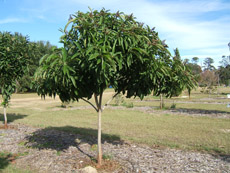Eriobotrya japonica (Loquat)

*Click on picture for more images of this species.
- USDA Hardiness Zone: 8A - 11
- Mature Height: 20 to 30 ft
- Mature Spread: 30 to 40 ft
- Growth Rate: Moderate
- Availability: Generally available
- Drought Tolerance: Moderate
- Salt Tolerance: Moderate
- Light Requirements: Full sun to partial shade
- Soil Drainage: Needs a well-drained site
- Native Origin: INVASIVE POTENTIAL - Use with caution in Central and Southern zones of Florida. Not considered a problem species in North Florida.
- Foliage: Broadleaf evergreen, with no showy fall color.
- Flowers: White, showy flowers with a pleasant fragrance that appear in fall and winter.
- Pests: Sensitive to fireblight which can cause significant foliage browning in summer. Scales and caterpillars are occasional problems.
Description: The dense, rounded, dark green canopy of Loquat is decorated in USDA hardiness zones 8b through 11 in late winter and spring with clusters of apricot yellow, pear-shaped, edible furry fruits. Fruit rarely sets further north. Loquat is a rapidly-growing evergreen tree and can reach 25 to 30 feet in height in the shade but is frequently seen 15 feet tall with a 15 to 25-foot-spread in a sunny location. The 10 to 12-inch -long leaves are rusty-colored beneath and have a coarse texture. Fragrant clusters of creamy white flowers are produced in fall, followed by the delicious, brightly colored, winter fruit.
Its neat habit and compact growth make Loquat an ideal specimen or patio shade tree, and it can be used as a residential street tree or median strip tree in areas where overhead space is limited. But an adequate clear trunk needs to be developed early in the life of the tree to provide for vehicle clearance. Branches will have to be pruned to grow up, as they tend to droop with time under the weight of the developing branch. It is not suited for planting next to the street if trucks pass close to the tree since adequate clearance is not possible but is successful in wide median strips. It also blends well into informal shrubbery borders and the fruit is attractive to wildlife. It espaliers well against a sunny wall, and makes a good screen due to its dense canopy. Sprouts along the trunk can be a maintenance nuisance.
Providing best fruit and form when grown in full sun, Loquat can tolerate partial shade and a variety of well-drained soils. It grows well on soils with a high pH and maintains the characteristic dark green foliage. Clay soil is acceptable as long as there is sufficient slope to allow surface water to run away from the root system. It often looks best in the southern portion of its range when given some shade in the afternoon, especially if it is not irrigated. Loquat should be well- watered until established, but can then survive periodic droughts. Do not overfertilize since this could increase sensitivity to fire blight disease. Trees can be short lived unless soil is well drained and there are no root defects present in the root system. It performs well along the coast with some protection from salty air.
Gainesville Observations: Trees are growing well and are vigorous. Two have been pruned to a central leader and dominant trunk for use as a street tree with relative ease. Growing trees in this manner should be simple and will provide a new produce to the market. Flowers appear in January and fruit matures late March to early April.
Fact Sheet (pdf)
Click here for more photos of this tree.

